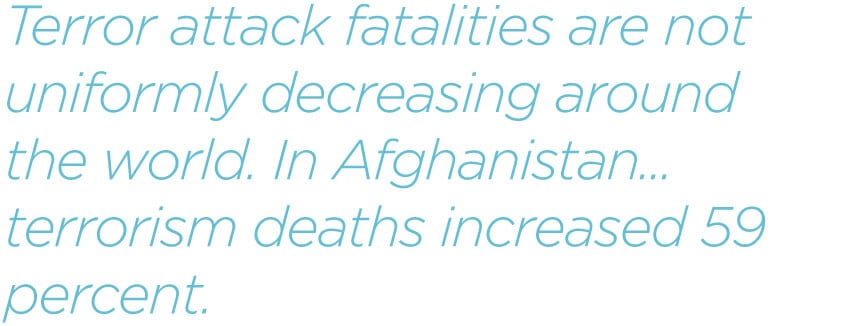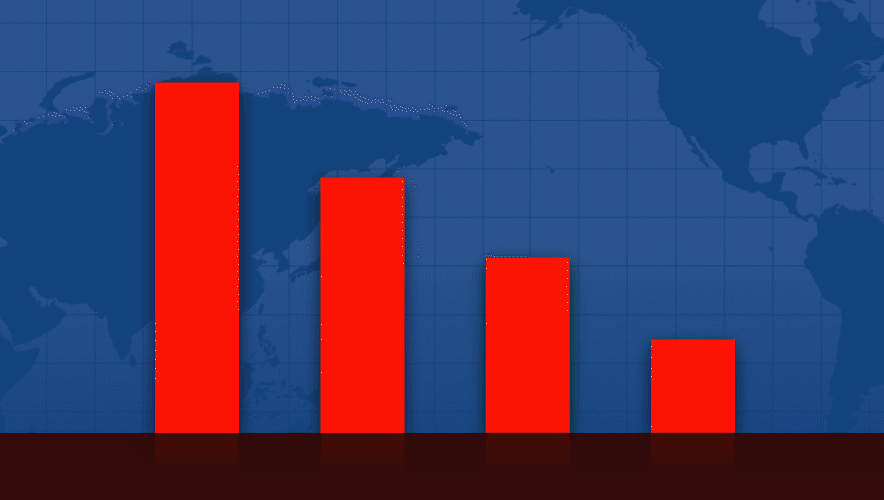Fatalities from Terror Attacks Continue to Decrease
For the fourth consecutive year, deaths from terrorism worldwide have declined, according to the latest edition of the Global Terrorism Index (GTI). This means that total deaths from terrorism are now down more than 52 percent from their peak in 2014.
Nonetheless, terror’s tentacles still have a grip on countless countries around the world, according to the GTI, which is produced by the Institute for Economics and Peace and based on data from the University of Maryland’s National Consortium for the Study of Terrorism and Responses to Terrorism (START) Global Terrorism Database. In 2018, the last full year for which data was available, 103 countries recorded at least one terrorist incident, and 71 countries suffered at least one fatality from a terror attack. This marks the second worst year on record for the number of countries suffering at least one death.
“Although the intensity of terrorism has diminished, its breadth has not,” the report authors write. “It highlights the need for continued assertive international action to combat terrorism.”
Bombings and armed assaults have remained the most common types of terrorist attack over the past two decades, according to the report.
In sum, the GTI sketches out global trends in terrorism in the last 50 years, with an emphasis on trends since 2014—the year which some say marked the beginning of the fall of the Islamic State (ISIS).
The decline in terror deaths is due to a few factors, the report found. One is success in fighting ISIS and Boko Haram; the number of deaths attributed to those two militant groups totaled 15,952 in 2018, a 15 percent decrease from 2017.
Of these two groups, ISIS’s decline seemed the most marked. Deaths attributed to attacks by ISIS decreased 69 percent in 2018, with the number of attacks dropping 63 percent. The group continues to lose fighters. It now has an estimated 18,000 fighters left in Iraq and Syria, down from more than 70,000 in 2014, according to the report.
Another factor is the improving situation in Iraq. Roiled by terrorism for more than a dozen years, Iraq’s terrorism death toll decreased by 75 percent in 2018. Although the death toll in Iraq was still high (3,217), 2018 marked the first year since 2003 that the country was not the most impacted by terrorism in the world—Iraq was second to Afghanistan. Somalia and Syria also saw reductions in terror deaths in 2018.
And in Somalia, the report found some success fighting the militant group Al-Shabaab, which has been the target of airstrikes by a U.S.-led coalition. Somalia recorded the second largest (behind Iraq) reduction in deaths in 2018, with 824 fewer deaths recorded than in 2017.

But terror attack fatalities are not uniformly decreasing around the world. In Afghanistan, which replaced Iraq as the country most affected by terrorism, terrorism deaths increased 59 percent to 7,379 in 2018.
“The increase is closely aligned with the increasing intensity of the civil war,” the authors write. “There has been a constant increase in both terrorism and battlefield deaths over the past decade as the security situation continues to deteriorate.”
With the increase of fatalities in Afghanistan, the Taliban overtook ISIS as the world’s deadliest terrorist group in 2018.
Besides Afghanistan, only three other countries suffered a significant uptick in terror attack deaths in 2018: Mali, Mozambique, and Nigeria, with each recording an increase of more than 100 deaths.
The report also discusses several recent global terror trends. One is the increase of far-right ideological terrorism in the West, particularly in North America, Western Europe, and Oceania.
Worldwide, the total number of incidents motivated by right-wing ideology increased by 320 percent during the past five years. In 2018, total deaths attributed to far-right groups increased by 52 percent, from 11 in 2017 to 26 in 2018. But by the end of September 2019, when GTI data ends, the 2019 number had nearly tripled to 77 deaths.
“The three largest politically motivated terrorist attacks in the West in the last 50 years have been perpetuated by far-right extremists,” the authors write.
Yet far-right ideology is not even close to being one of the leading motivations for global terror attacks.
“Far-right terrorism remains a small fraction of total terrorism worldwide,” the authors explain. “Even in the West, historically nationalist or separatist, Islamist, and far-left terrorism has been much more common.”
And terror attacks on the whole remain less common in the West than in other regions of the world. Between 2002 and 2018, 93 percent of all terrorism deaths took place in South Asia, the Middle East and North Africa (MENA), and sub-Saharan Africa. Overall, the report found that the South Asia region suffered the highest impact from terrorism since 2002, while the Central America in and the Caribbean regions had the lowest impact.
Although the GTI does not cover 2019 in full, another recent report, Terrorism & Counterterrorism in 2019: The Year in Review, does provide analysis for that year. The report was issued by the Foreign Policy Research Institute (FPRI), a think tank that produces nonpartisan policy analysis of national security issues.
“2019 was a year of highs and lows for counterterrorism forces around the world,” writes the report’s author, Colin Clarke, a senior fellow at FPRI. The high points included the killing of Hamza bin Laden, son of al Qaeda founder Osama bin Laden and the group’s heir apparent. “Hamza’s death is a major blow to al Qaeda,” Clarke writes.
As for the low points, Clarke cites the high-profile terrorist attacks in Christchurch, New Zealand; El Paso, Texas; and various sites throughout Sri Lanka. All resulted in significant fatalities.
What will 2020 hold? Clarke writes that he expects “a battle for supremacy between ISIS, as it attempts to rebuild, and al Qaeda, a group poised to take advantage of power vacuums in failed states.” He also predicts a continued surge in violent transnational white supremacy.
And, like in so many other areas, technology is likely to play an increasing role.
“We should also expect terrorists and terrorist groups to continue flirting with new technologies in an attempt to harness the power of drones, 3D printing, and artificial intelligence as force multipliers,” he adds.
